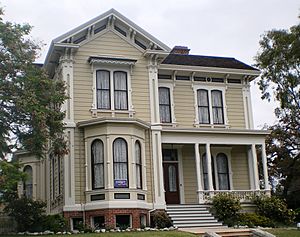Foy House facts for kids
The Foy House is a beautiful old house in Los Angeles, California. It was built in 1872 and has a special style called Victorian Italianate. This means it has fancy details and a grand look, like buildings from Italy. It was one of the very first buildings in Los Angeles to be named a Los Angeles Historic-Cultural Monument, which means it's a really important historical place.
Where Was the Foy House First Built?
The Foy House was first built in 1872. It stood on land that was once part of the original Pueblo de Los Angeles. This was the old Spanish settlement that grew into the city we know today. The house was at the corner of 7th Street and Figueroa Street in Downtown Los Angeles. Back then, Figueroa Street was called Grasshopper Street!
A man named Samuel Calvert Foy bought the land in 1872. He paid $1,000 for it. Samuel Foy had moved to Los Angeles in 1854. He owned a very successful business that made harnesses for horses. It was the oldest business in the city when he passed away. Samuel Foy also worked as the city's Chief of Police for a while.
He built the Foy House for his family. It was where he, his wife Lucinda, and their five children lived. People said it was the first three-story building in Los Angeles. At the time, the area felt like it was "way out in the country." A famous architect named Ezra F. Kysor is thought to have designed the house.
Samuel Foy's daughter, Mary Foy, became very important. She was the first woman librarian in Los Angeles. She worked there from 1880 to 1884. Mary Foy was also a leader in the Women's suffrage movement. This movement worked to get women the right to vote. She was also a leader in the Democratic Party. She was the first woman to be part of a major political party's national committee.
Samuel Foy passed away in 1901. But his wife, Lucinda, continued to live in the house. Over time, the area around the house became a busy business district. The land became very valuable.
The House Moves to Witmer Street
In 1919, the Foy family sold the property. The new owner planned to build a large building there. So, the Foy House had to move! It was moved to a new spot at 631–633 South Witmer Street. This was near Wilshire Boulevard and across from Good Samaritan Hospital. The exact year it moved is a bit unclear, but it was around 1920.
For over 30 years, starting in 1951, the house was used as an office. It became the main office for Magma Power Co. This company was a pioneer in geothermal energy. Geothermal energy uses heat from inside the Earth to make power.
In 1962, the Foy House was officially named a Los Angeles Historic-Cultural Monument. It was only the eighth building in the city to get this special title! In 1974, Magma Power spent $50,000 to fix up the house. They even hired a famous set designer named F. Keogh Gleason to help with the inside. He had won five Oscars for his work on movie sets!
In the early 1980s, a businessman named Ben Weingart gave the house to Good Samaritan Hospital.
The House Moves to Carroll Avenue
By the early 1990s, the Foy House was starting to look old and worn out. In 1992, Good Samaritan Hospital made a deal. They agreed to help move the house again. A lawyer named James Prager agreed to restore it. He owned another old Victorian home nearby.
In December 1992, the Foy House was moved for the third time! Its new home was at 1337 Carroll Avenue. This street is in a historic area called Angelino Heights. Many old Victorian houses have been moved there to be saved. The Foy House was the seventh house to join this special neighborhood.
The Foy House has even been on TV and in movies!
- From 1998 to 2006, it was shown in several episodes of the TV series Charmed.
- In 2011, it was used as the outside of a house in the movie "J. Edgar."
- In 2012, it was featured in the movie Guilt Trip.


